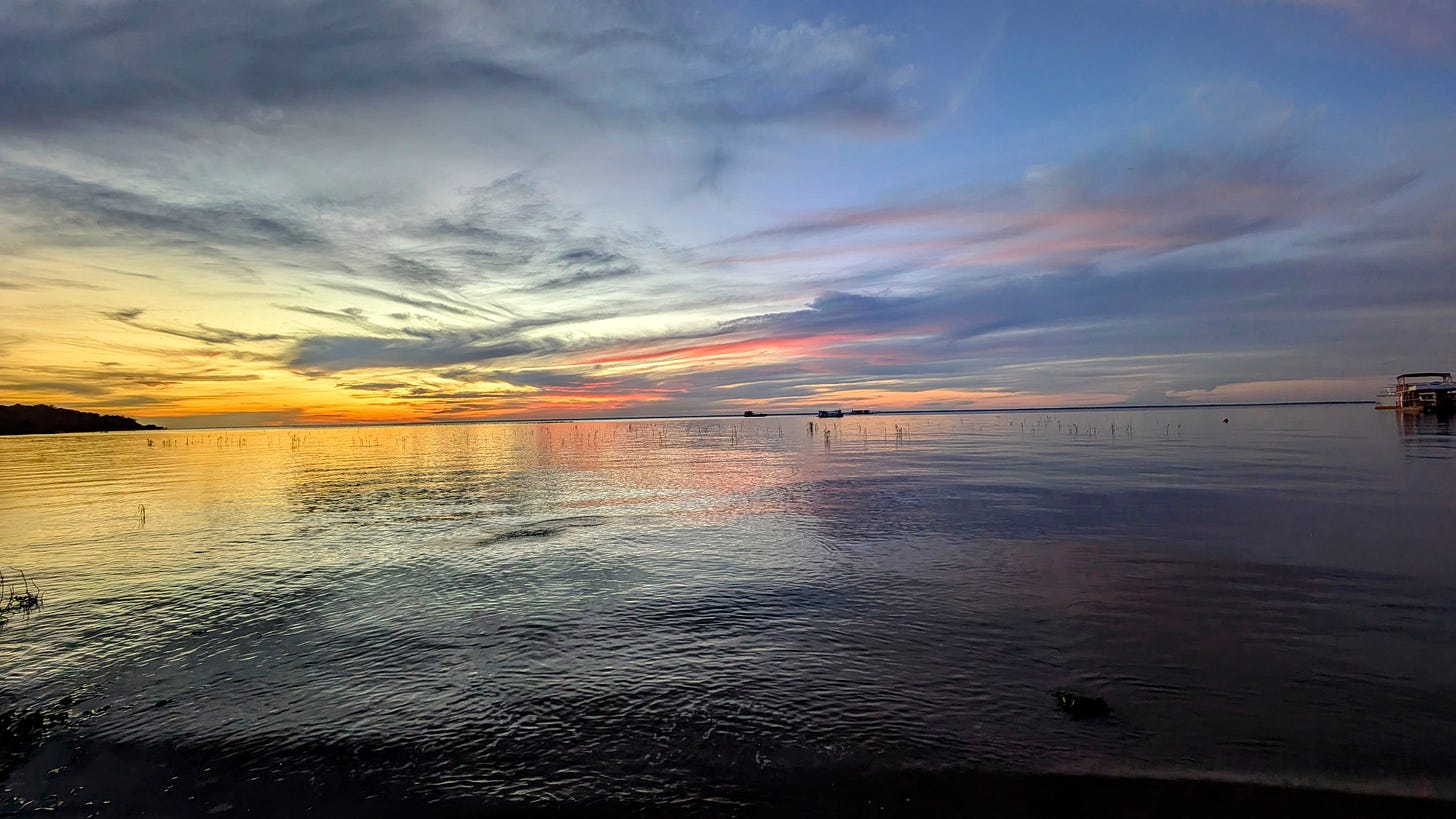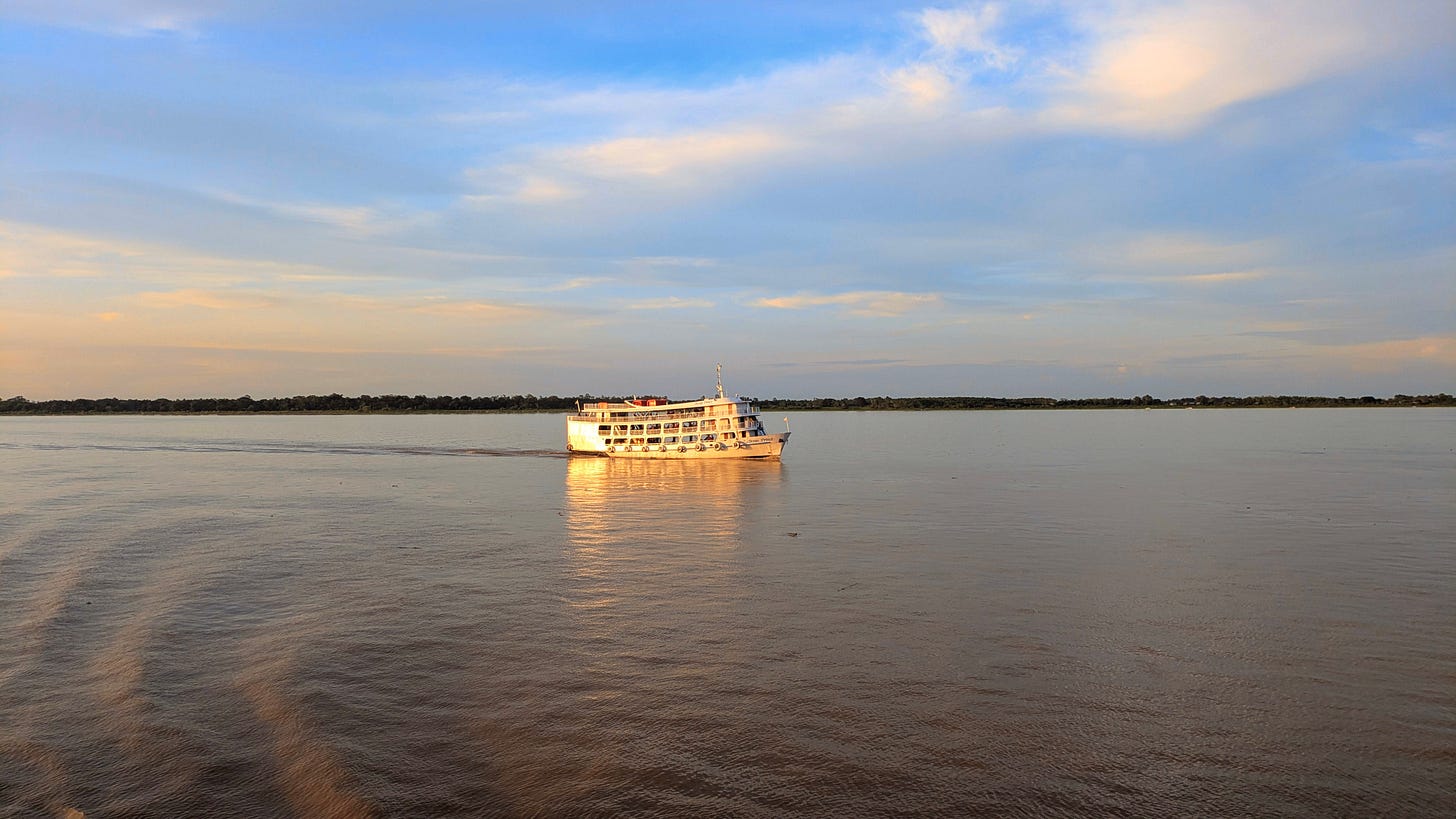I was flopping around in a hotel swimming pool in Alter do Chão a few weeks ago, ecstatic to be cooling off after another long, hot bus ride, when a Scottish voice signalled to me across the water. Theresa and I had already clocked each other as the only two pale people in the vicinity – and the novelty of that is often enough to start a conversation when travelling through Brazil.
She was certainly the first Scot I’d come across in my sixteen months of travelling, and maybe the second or third British backpacker I’d had a conversation with in that time. We had a lovely chat about life, travels, buses, and all the rest. She was two months into her trip. “Only one month left,” she told me, “and then that’s my 90 days used up sadly!” Huh, I thought to myself. That’s odd, because Dave and I have definitely been in Brazil for longer…
Yes, we’d outstayed our visas. Me only by a couple of days, but Dave quite dramatically, given his enforced solo holiday to Londrina back when I abandoned him to go to a wedding in October. I felt like an idiot for not having checked such a thing – but so many countries in Latin America allow British passport holders a generous 180 days that I’d not put much thought into it. Imagine if Dave got fined, banned from re-entering Brazil, imprisoned?? all because he’d spent two weeks in an Airbnb in Brazil’s least gregarious city watching Lord of the Rings in his pants.
While jail time seemed unlikely, we thought it best to step into gear and make tracks for the next place as soon as we could. It was a shame, because until that moment we’d been considering extending our stay in this idyllic little beach town on the Amazon, but needs must: it was time to hit the Guyanas and see what on earth was going on up there.
From Manaus, following our most recent Amazon tour, it made sense to continue northwards and into French Guiana. Neither Dave nor I knew of anyone who had been before, or even anyone who knew anyone who had – quite possibly because we don’t know that many French people – and so we had very little idea of what to expect. And that was a pain, because there is scant information about on how to navigate these parts, especially without a car.
None of the English language guidebooks spare much time for the Guyanas, either, which further added to the mystery. I downloaded a promising looking book, the French Guiana Travel Guide, onto my Kindle, but my optimism flatlined when I quickly realised it had been written by AI – and I’m not just trying to insult the author here, I think it was quite literally written by Chat GPT and self-published by a crafty-thinking man/entity with the pseudonym of “Newman S. Jackman”. It is so full of horseshit that it’s funny and I almost don’t want to delete it from my device. I’m talking made up place names, endless paragraphs describing transport concepts like Uber (which doesn’t operate in French Guiana) and recommending the use of “internet-based map tools”, aka Google. And no, I’m not worried about Newman S. Jackman suing me because I'm fairly confident he doesn't exist.
We decided we’d find our way to French Guiana by boat. From studying the internet-based map tools, it seemed logical and more pleasant to continue pootling up the river than take a series of buses. We’d travelled down the Amazon River by cargo ship once before when we made our way to Iquitos in Peru last year, so we had an idea of what to expect, ie. not luxury. It felt like we’d hit the jackpot, therefore, when we discovered that our first slow boat (from Manaus to Santarém) had an on-board bar and buffet service – quite the upgrade from the thrice-daily serving of chicken broth we were given aboard the Edwardo X in Peru. And where our Peruvian vessel was stocked high with vegetables, eggs and live cows, this one carried dozens of shiny new motorbikes alongside two actual lorries.

We are very accustomed to sleeping in hammocks by now, and I was pleased with our set-up on the higher deck towards the front of the boat so that we had a nice breeze. We commandeered some space between a sweet retirement-age couple, an old lady on her own, and a group of mid-life huns on their way back from some huge family trip to the city. A wholesome network. Everyone was curious about us and we did our best to make conversation with our limited Portuguese, grateful when each group respectively gave up once the basics were established and the range of my vocab was very much exhausted. The old woman returned to reading her religious textbooks out loud and the couple presented me with a gift of a souvenir keyring from 2021 in the shape of a heart with some bible quote on it. A few minutes earlier, a man selling snacks had handed me a Jesus flyer. Did all these people know something about the journey ahead?
On our second day on board, the city-break huns shared some cake with us, and later a cup of home-prepared farofa, which is a side dish made from cassava flour… At the risk of offending every Brazilian person out there, I would describe farofa as a sort of salty, grainy sand – a bit like if you were to pour out one of those ready-flavoured instant sachets of couscous onto your plate without hydrating it in water first. Brazilians love it and you’ll find it on the side of every meal but I’m stumped as to why. Of course, being polite awkward British people we took the huge cup she’d poured us gratefully and made appreciative sounds, trying not to choke on salt dust as we performatively swallowed down a couple of mouthfuls. Clearly we’d been too polite because she brought over a second cup soon afterwards and we went through an embarrassing exercise of politely and then forcefully declining her offer.
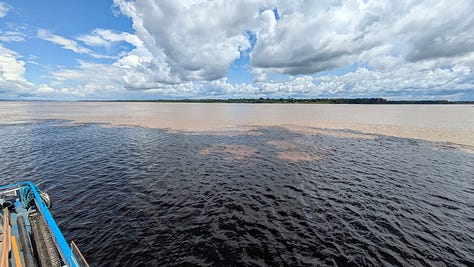
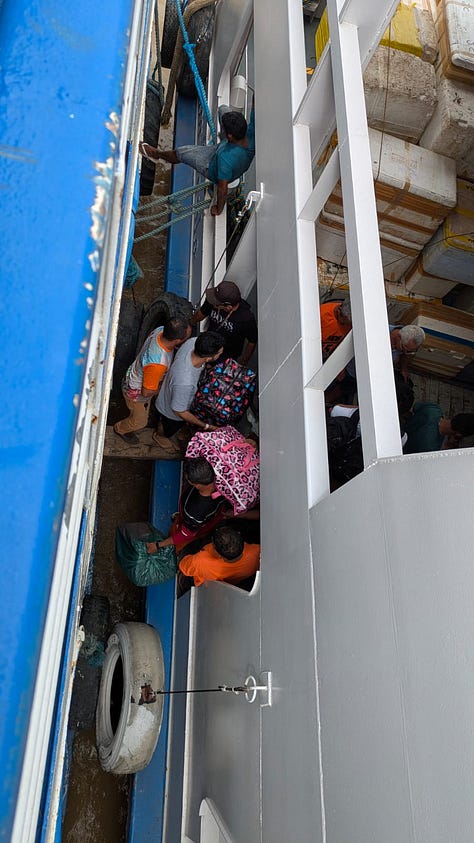
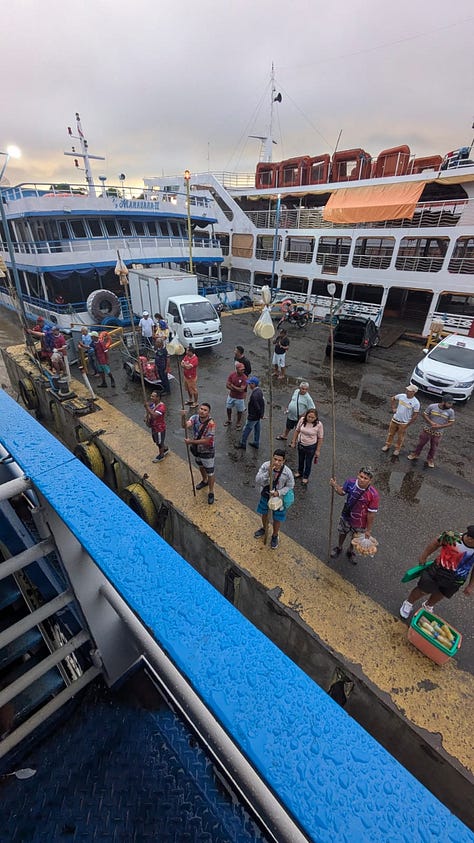
As we edged towards Santarém, the boat stopped abruptly, somewhere near the tiny port of Santa Júlia on the Amazonas / Pará state line. A huge team of border police came on board with German Shepherds. We passengers were told to clear the floor of belongings and tie our hammocks up and out of the way so that they could check our bags for smuggled goods. I thought about some of the strange things we’d been carrying in our bags for so long – scraggy half-used bags of spice mixes; half a coke bottle full of white laundry powder – but figured if threatened with torture I’d offer up the accidental video footage I’d recorded of a guy snorting loads of cocaine up on the top deck earlier that day (I was trying to make a charming time lapse of the boat). As it happened, the officer who came to check us was very excited to meet two British backpackers and practice his moderate English by asking us if we had enjoyed the trip down the river and the scenery. I don’t think he’d have wanted his day ruined by the admission of witnessed onboard crimes.
We stayed in Santarém for two nights, enjoying the luxury of land, a bed and intermittent air conditioning, before hopping a couple of hours west to that paradisiacal little spot on the Tapajós river, Alter do Chão. If you look at the map, you’ll see from above the difference in colour between the Tapajós and the Amazon tributaries – the two don’t mix, and it’s even stranger to witness on the water. We saw the same phenomenon leaving Manaus, where the Amazon meets the Rio Negro: the Amazon carries lots of sediment and its water comes all the way from the Andes, so is cooler (22°C); the Negro is clearer and warm (around 28°C), moving much more slowly, so the two rub alongside each other for several kilometres. Madness.
Anyway, Alter do Chão started popping up in a lot of conversations and websites we’d read while figuring out how to go about this part of the journey. Its white sandy beaches and beautiful clear water have earned it a place on various lists of “best beaches”, something that sounded so out of place this close to the murky Amazon, and so we thought we’d better go and check it out.
Fast forward to my enlightening conversation with Theresa, and we wrapped up our short but sweet stay in the small hippie town of stellar sunsets and Argentinians. A bus ride back to Santarém; a sweaty, investigative plod around various ports marked on the map until we found the departure point for the boat to Macapá, our next destination on the way out of Brazil.
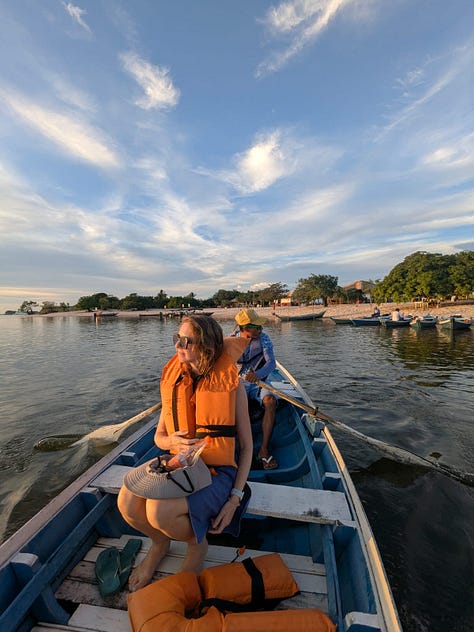
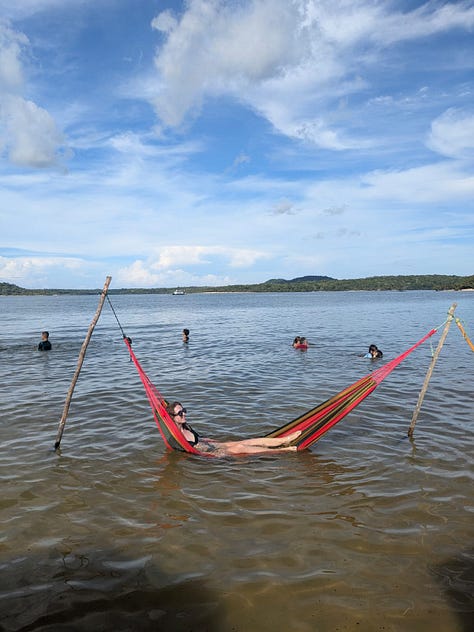
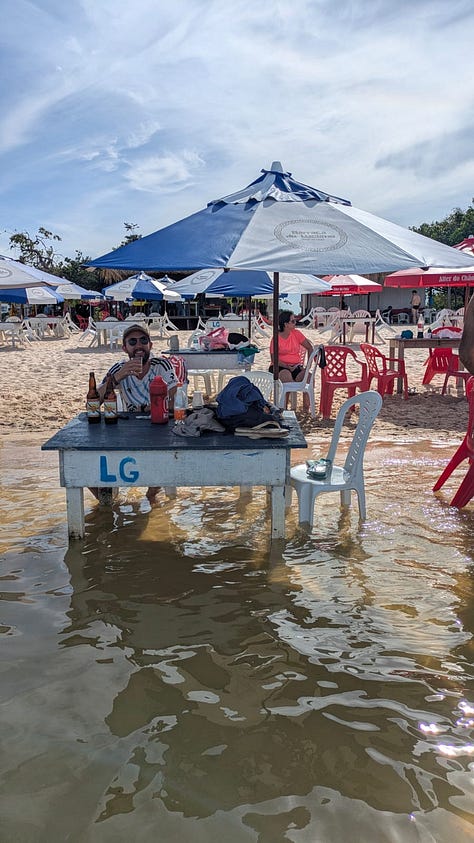
Call it intuition or premonition, but when we boarded the next cargo boat to Macapá I didn’t get as comfortable a feeling as before. The demographic was different – a top deck populated almost entirely by male solo travellers – but maybe the novelty of multi-day hammock travel was also wearing off. Still, we settled in for the two-night journey, and I felt better once we got moving and the breeze began to cool us down.
We made awkward friends with the hammocks next to us: two guys who worked in IT for a Canada-owned gold mining company out in the rainforest. They spoke no English, but we managed to understand each other, and I leant them my bottle opener when I saw them struggling to open the beers from the giant cooler they’d brought with them for the journey. In return, Dave and I were presented with beers – and I don’t think the other two stopped drinking for the full 36 hours on board.
They made this journey every couple of weeks, we learned, 14 days on and 14 days off. Do you like it, I asked? No, the friendlier one told me, it’s boring. He said it so seriously that I almost felt embarrassed. And yet they were clearly proud of their jobs – proud to work for a big international corporation –showing us videos of the company on YouTube when their phone signal allowed for it. Watching the videos – some introductory “who are we” sort of creations for international investors, I presume – Dave and I made all the correct noises of being impressed, but the corporate spiel was kind of horrifying. I kept waiting for the greenwash moment – for a hard-hat scientist to talk to the camera about how the company was planting X number of trees or providing clean drinking water for X village. But it never came. Instead the trailer showed us scene after scene of muddy, deforested areas of rainforest followed by groups of suits posing with gold bars in their hands and a voiceover explaining profit projections. Eerie.
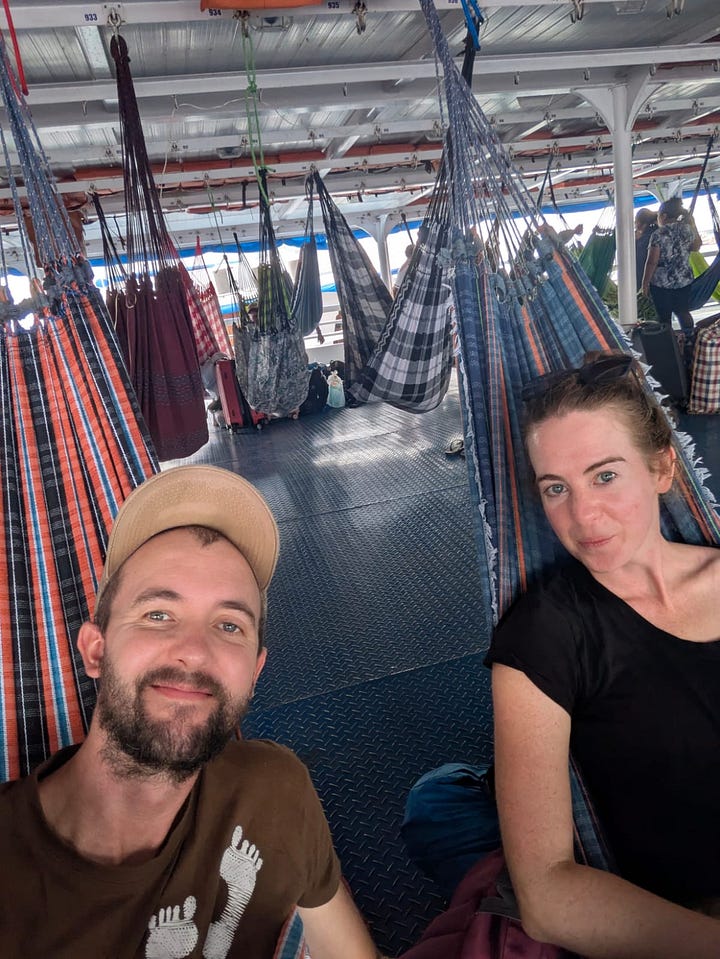
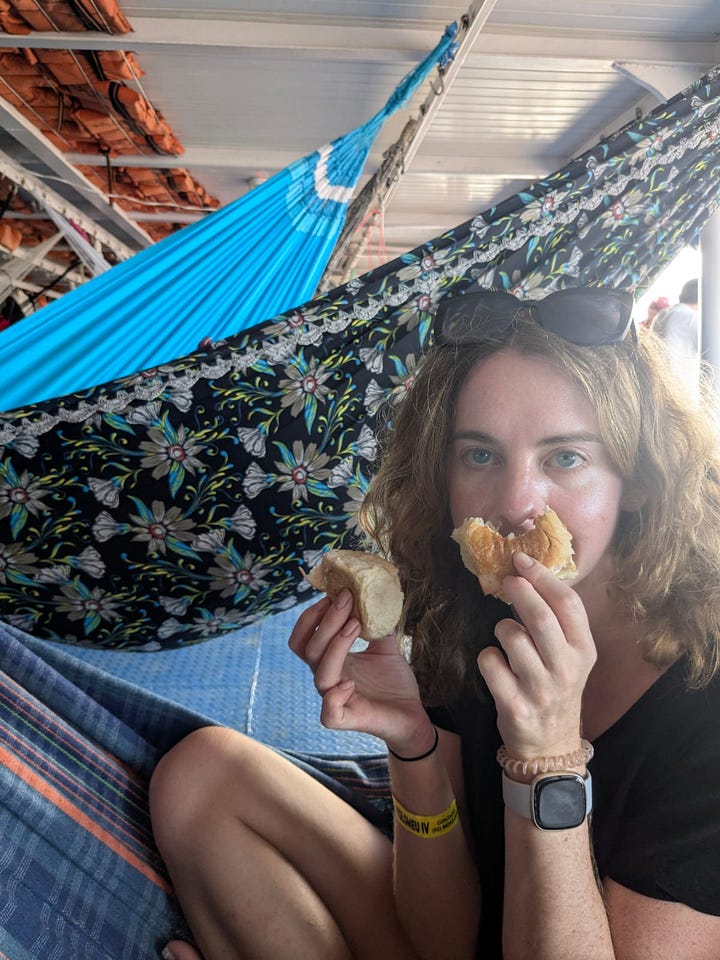
The weather shifted and suddenly it felt like both the sky and the river were inside our boat. Crew scrambled to pull tarpaulin sheets across the open sides and bags and hammocks were hurriedly moved further into the middle of the deck, but the rain was so absolute that it was difficult to escape. Bad weather and no internet made people restless and the small bar at the back of the boat got a thrashing. I did get to sleep eventually with my plastic poncho wrapped around me, but Amazon is wide enough to feel like the sea at times and the storm's waves made my hammock swing violently through the night.
Our second day on board was drier, and we spent it dozing and reading in our hammocks while the single lads’ party continued around us. We'd expected to arrive in Macapá early the next morning (day three) but I wasn't prepared for just how early. At around 2.30am the boat docked and all the lights went on while the cargo was unpacked, possibly also to try and smoke us out. Luckily nobody kicked us off and we hung about catching bits of sleep until daylight came.
From the port we took a cab to Macapá’s humble bus station, crossing the equator unceremoniously somewhere along the 15 minute journey down the motorway. The bus we needed didn’t leave until the evening, so we spent a funny day touring Macapá’s limited café and restaurant offerings and contemplated our next steps.
Arriving in Oiapoque early the following morning, we stumbled across town with our bags once more, donating my soggy hammock, which had also split down the middle during the night, to the bus station’s resident tramps on route. By this point in our journey it had been three nights since we'd slept in a room and a bed; five nights out of the last ten had been spent in hammocks. I drew on my last energy reserves to face the border control officers with my friendliest idiot tourist face in anticipation of our visa penalty.
The Brazilian border control office was a tiny room occupied by one security guard and one police officer, who was friendly enough and stamped our passports quickly. But just as I thought we'd got away with it, he sent us to sit on the naughty chairs while he typed for a bit and considered a suitable punishment for outstaying our 90 days. There was nobody else there queuing – surely a first for a border crossing – so I imagine this waiting time was largely for show, and Dave and I practiced our “sorry” faces and sat with our heads in our hands.
Eventually he called us up to his counter, one by one, to deliver a verdict: a 100 Brazilian Real fine for me (about £13.75); 105 (about £14.50) for Dave. Quite the result considering we thought we might be fined 100 BRLs for each day in breach. The biggest joke was that we weren't able to pay the fine since it was a Sunday – so we received a piece of paper with a reference number and were told to come back to Brazil to pay it within a month.
Finally, we walked to the river dividing Brazil and French Guiana, where designated blokes with boats sat waiting to ferry passengers over to the other side. We paid a man with a baseball cap that said “I’m the daddy” 50 Reals (£6.90) to take us across in his dugout canoe, and there was France, looking suspiciously like Brazil.
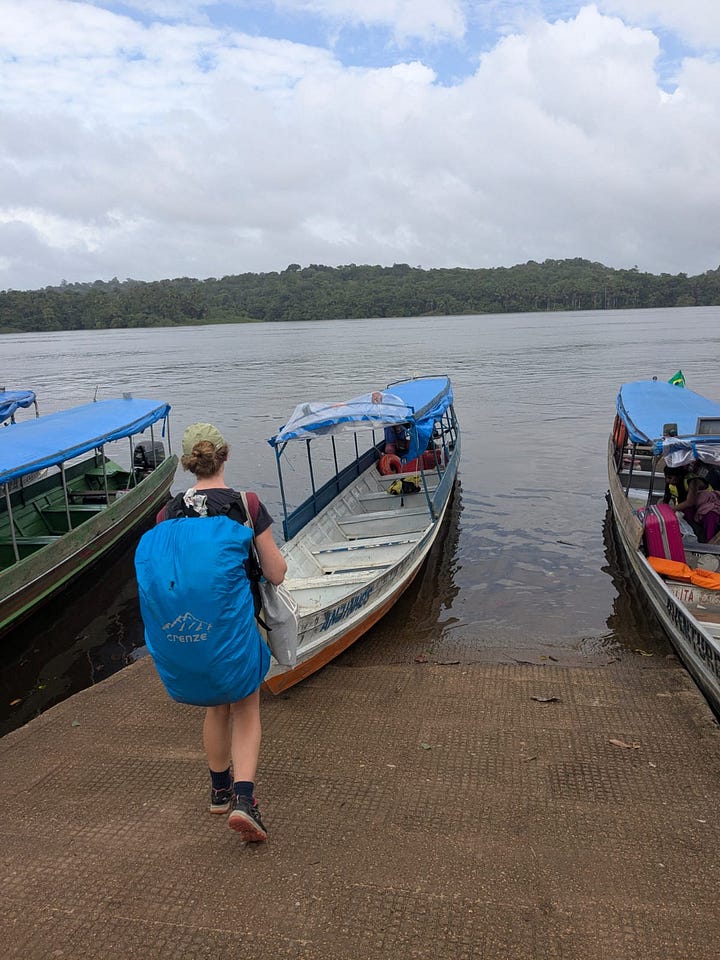
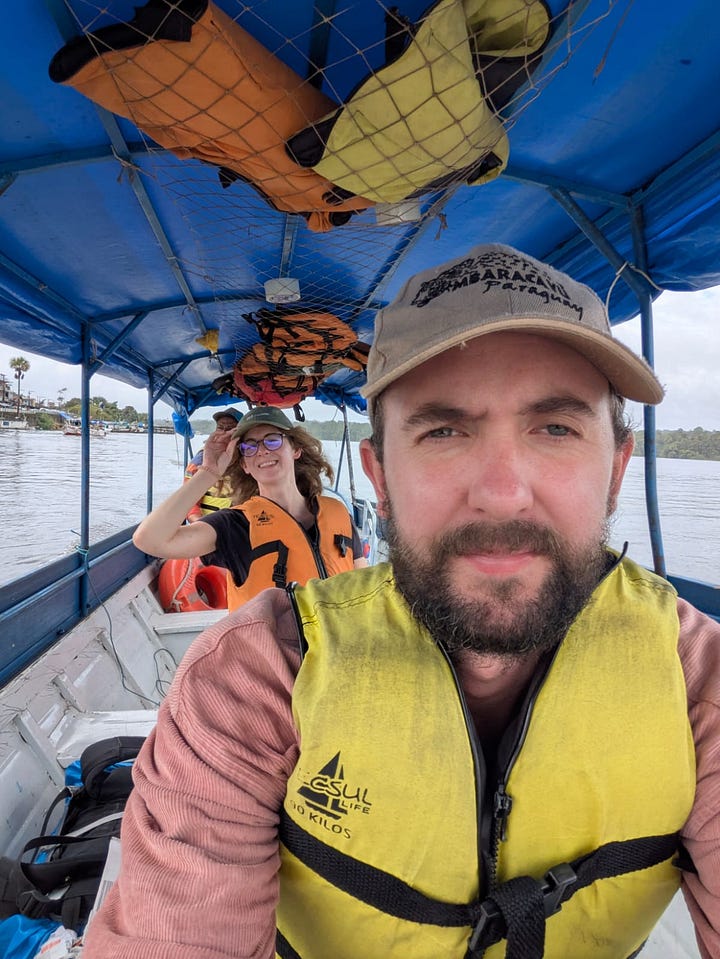
As has been the case with every country on this trip, I was sad to leave Brazil, but I’ll admit it took me a while to settle into it the second time around (we dipped a toe back in April last year). I felt sort of guilty about it, but on reflection maybe it’s not so surprising considering how culturally different Brazil feels to the rest of Latin America.
To start with the obvious, they’re the only ones on the continent to speak Portuguese and it took me a while to make myself understood. That felt frustrating after a year spent speaking Spanish every day and gaining confidence in it. Brazil is also huge, so there are many different regional dialects to get used to (though I’d argue none are so far removed from each other as, say, London and Glasgow) and plenty of places where our strange foreign accents were met with irritation, or just complete disbelief.
Because yes, did I mention Brazil is huge? Intimidatingly so – it’s almost as big as the US by square kilometre, or the whole of western Europe. It was overwhelming trying to work out how to see it all, and we soon surrendered to the fact we couldn’t.
Now that we were leaving of course, I was gutted. I’d loved getting to know so many different regions and accents. I’d adapted to the fierce humidity (mostly) and been completely spoilt by so much beach time, jungle adventures and really, really good food. Most of all, I’ll miss the absolute commitment to fun that seems to embody the Brazilian spirit – it’s easy to start taking for granted the fact you’re never far from a decent bar, with music and people throwing back beers and caipirinhas like it’s their last day on earth, no matter whether it’s a Monday or a Friday. No one else enjoys life quite like the Brazilians.
Travel bits and tips from this week
From Manaus, Dave and I took the Bartholomew IV east to Santarém (we bought tickets from the office in the port). Like all the boats doing these Amazon routes, the ship was primarily carrying cargo but this one had three full decks for passengers and even a little bar at the back. BYOH (Bring Your Own Hammock).
In Santarém we stayed in a lovely room in this Airbnb and relished good food and dry land at Massabor Orla bar and restaurant out on the pier.
After two nights there we took the local bus from here to get to Alter do Chão. No point in following the bus timetable here, as it seems to leave at random intervals.
In Alter do Chão you can pay a little man to row you across the river to a very paradise-adjacent sandbank lined with bars and stunning scenery. We were advised to just stamp our feet a lot to keep the sting rays at a safe distance…
We stayed in an apartment at the Ilha Bela Flat Residence which was excellent value because it was still partly being built. Finding nice looking places to eat that were open was tricky but we enjoyed salads and burgers at Mae Natureza in the (tiny) main square.
On the boats our drinking and dining experiences were fairly limited to our packed lunches and chicken and rice from the buffet…
And in Macapá we went to the only café open before 10am, Cheirin Bao, which appeared to be leading Brazil’s huge efforts to give every citizen diabetes… every drink was multicoloured, coffees came with two different syrup shots included as standard, but they did some good pão de queijo.
Looking for a nice place for dinner before our bus that night, we stumbled upon Fratelli. It was unexpectedly fancy and had an actual violinist sitting on a mezzanine playing Vivaldi and Ed Sheeran covers.




